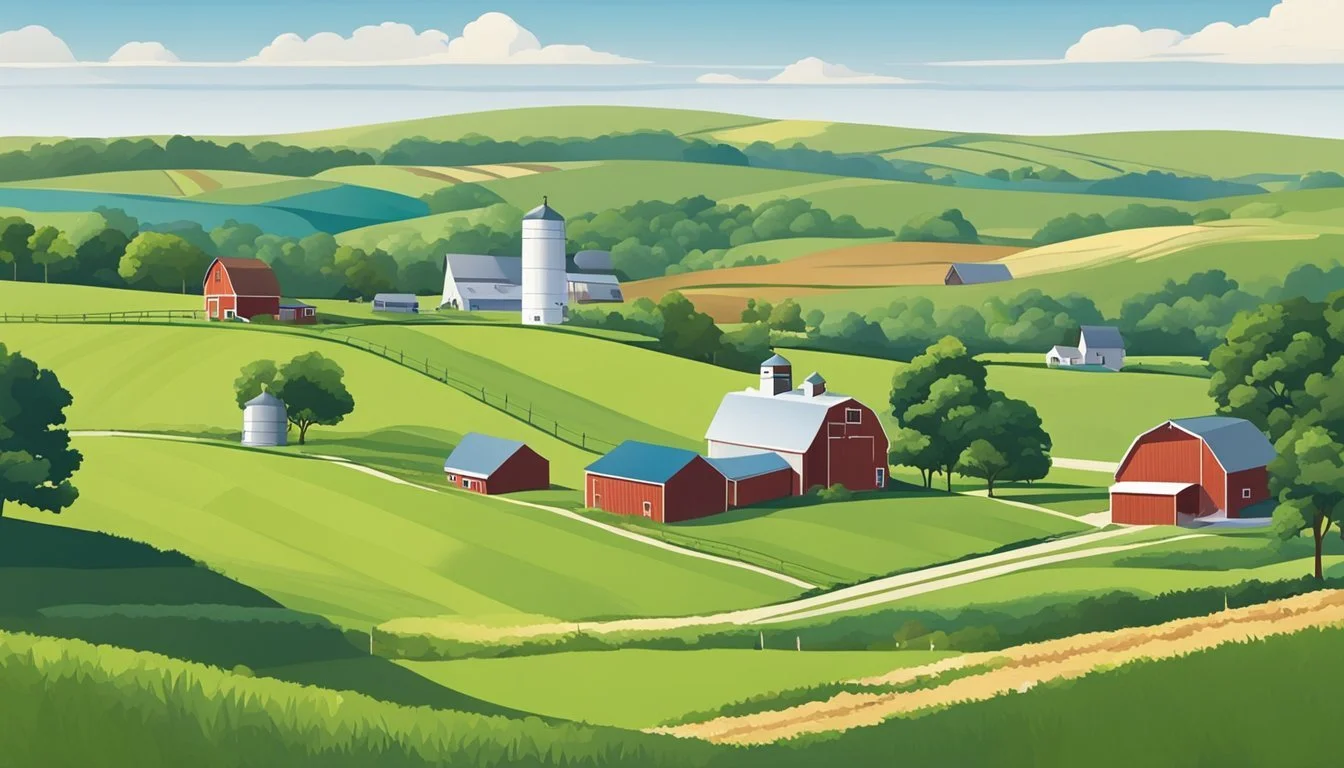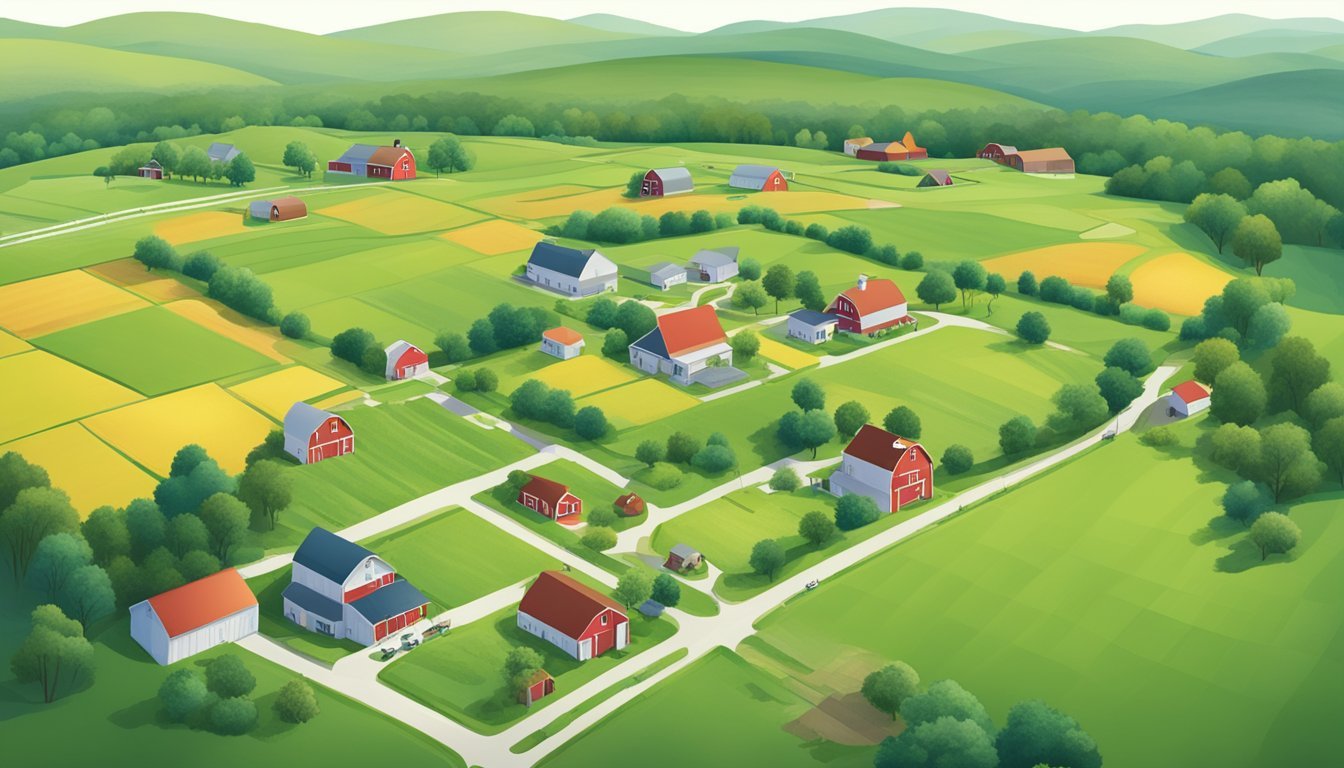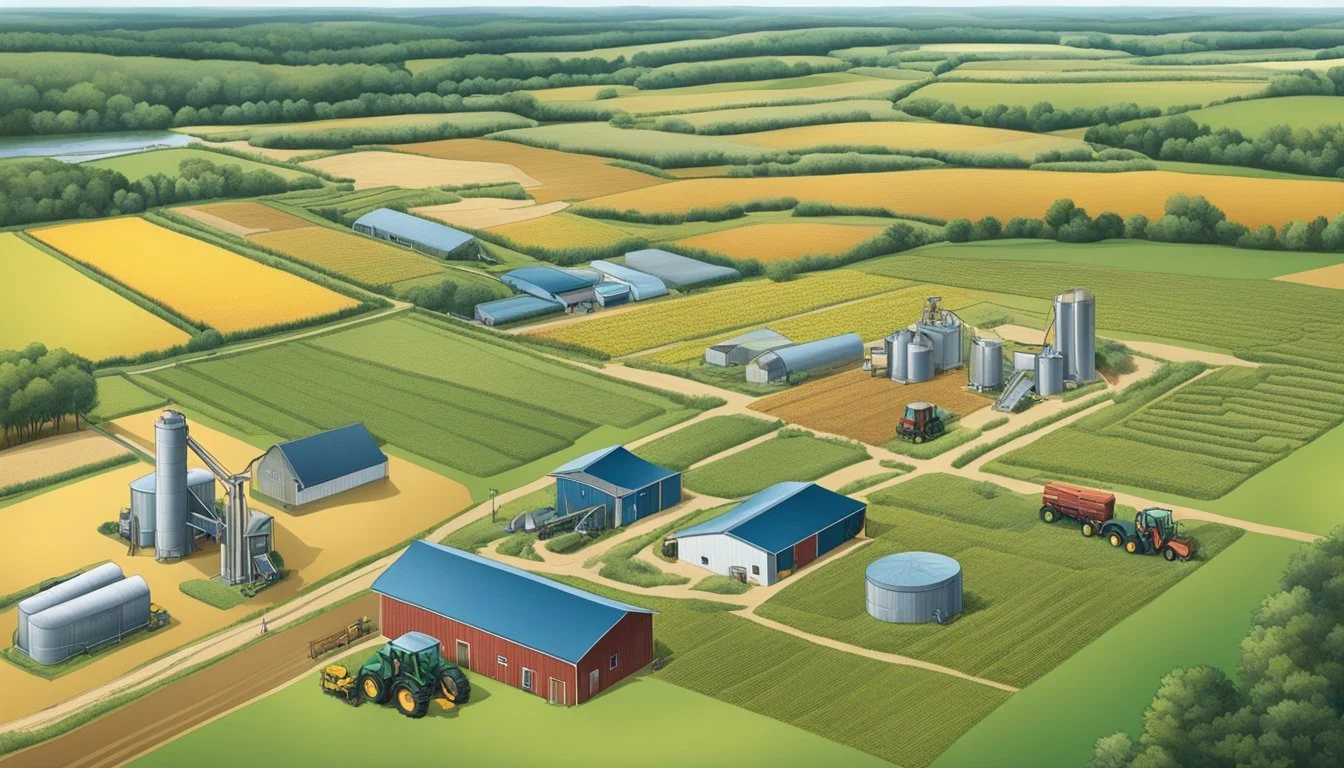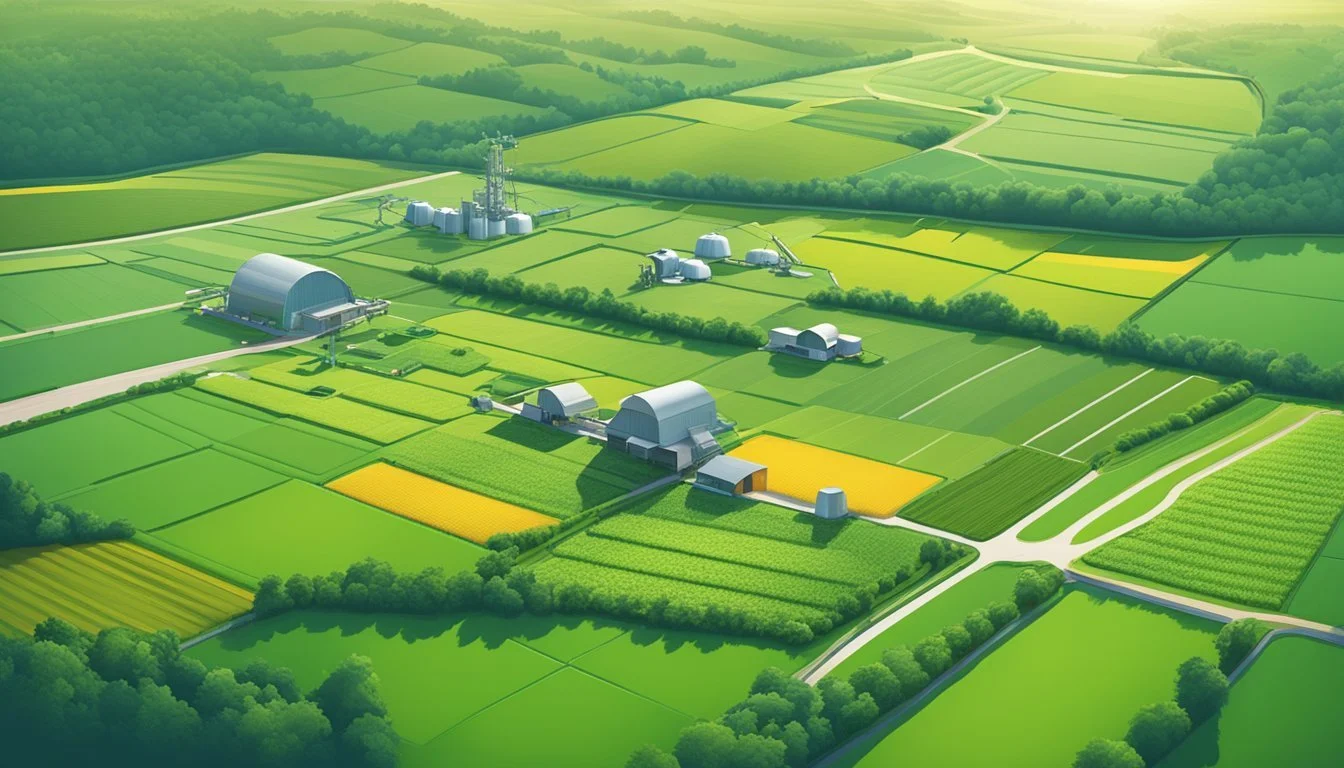Farming Communities in Maryland
Sustaining Tradition and Innovation
Maryland's farming communities are a vital part of the state's landscape, offering more than just picturesque views. These areas are rich with agriculture, providing diverse crops and livestock that contribute significantly to the local food supply. With over 8,000 acres of farmland for sale, Maryland presents abundant opportunities for those looking to delve into farming.
Small farms scattered throughout the state, from the rural stretches of Monkton to the charming outskirts of Friendsville, demonstrate the variety of lifestyle and agricultural practices available. Often surrounded by lush soil and ample water sources, these farms are ideal for both traditional farming and innovative agricultural ventures. Prospective buyers can find properties suited for everything from hobby farming to larger-scale operations.
Farmland in Maryland is not only about productivity; it's also about community. The residents of these rural areas take pride in their connection to the land and their contributions to the state's agricultural economy. These communities are integral in preserving the agricultural heritage that Maryland is known for. The mix of old farm houses, modern farmhouses, and historic plantation homes offers a glimpse into the state's rich farming traditions and future potential.
History of Agriculture in Maryland
Maryland's agriculture has undergone significant changes from its colonial beginnings to the modern era, shaped by historical events and technological advancements. Key developments include the transition from tobacco-based farming to diversified crops and the adaptation to climate change and sustainable practices.
Colonial Beginnings to 20th Century Transformations
Maryland's agricultural foundation was established in 1634. Initially, tobacco dominated as the main crop due to high demand in Europe. This focus persisted throughout the colonial period. By the time of the American Revolution, farming communities diversified, growing wheat and corn. The Eastern Shore earned the title "Breadbasket of the Revolution" for supplying flour to the Continental Army.
The 19th century saw continued diversification. The establishment of the Maryland Agricultural Experiment Station in 1888 heralded scientific advancements aimed at improving farming techniques. The depression of the late 1800s, however, hit farmers hard, leading to economic decline. High tariffs on manufactured goods further strained rural farming communities.
21st Century and Future Outlook
Entering the 21st century, Maryland's agriculture faces new challenges and opportunities. Climate change poses significant risks, impacting crop yields and water resources. As a response, there is an increasing emphasis on sustainable agriculture and adopting practices that minimize environmental impact.
The Maryland Agricultural Preservation Foundation plays a crucial role in safeguarding farmland from urban development, ensuring that farming remains viable. Looking towards 2030, the focus is on innovative solutions to enhance resilience and productivity in farming communities through technology and policy initiatives.
Adaptations in modern farming include a shift towards organic farming and local food production. The integration of smart technology and precision agriculture helps optimize resource use and improve efficiency. These efforts aim to secure a sustainable future for Maryland's agriculture amidst changing environmental and economic conditions.
Agricultural Industry Overview
Maryland's farming industry is a vital part of the state's economy, contributing billions of dollars annually and involving a variety of crops and livestock. The sector encompasses innovative practices and supports both small and large agribusinesses.
Key Crops and Livestock
Maryland's farmers cultivate a diverse range of crops. Corn, soybeans, and wheat are among the most significant. Corn and soybeans, in particular, dominate due to their high demand and adaptability to the region's climate.
Livestock farming also plays a crucial role. Poultry, especially chickens, is a prominent segment, followed by dairy and beef cattle. The variety of livestock supports a robust agricultural ecosystem, ensuring a steady supply of animal products.
Economic Impact and Industry Value
Agriculture is Maryland's leading commercial industry, generating around $8.25 billion each year. The sector employs approximately 350,000 people, highlighting its importance to both the rural and urban economies.
Farm operations span 2 million acres, with around 12,600 farms statewide. The net farm income lately exceeded $826.5 million, showcasing the financial health of Maryland's farming activities. The economic contributions from crop sales and livestock ensure a sustainable industry.
Agribusiness and Innovation
Maryland has a vibrant agribusiness sector, supported by innovative practices and research partnerships. The state's farmers are adopting renewable energy systems and have implemented projects like the Maryland Hemp Farming initiative.
Cover crops are used to enhance soil health and reduce erosion, while collaborations with universities drive research and development. These initiatives not only improve productivity but also ensure environmental sustainability, positioning Maryland as a leader in agricultural innovation.
Environmental Stewardship and Conservation
Farming communities in Maryland are actively engaged in fostering environmental stewardship and conservation. They implement sustainable farming practices, protect soil and water resources, and actively respond to climate change impacts.
Soil and Water Conservation Programs
Maryland's farming community participates in various soil and water conservation programs. Efforts include the use of cover crops to prevent erosion and improve soil health. The Conservation Stewardship Program (CSP) plays a vital role by encouraging farms to implement practices that enhance soil quality and reduce water runoff.
Farmers are also educated on the proper application of nutrients and fertilizers to minimize negative environmental impacts. Through the University of Maryland Extension (UME), valuable research and training are provided to ensure optimal farming practices are followed, securing both farm productivity and environmental health.
Preserving Chesapeake Bay
Preserving the Chesapeake Bay is a top priority for Maryland's agricultural sector. Farmers are involved in initiatives to reduce nutrient and sediment runoff that can pollute the bay. This collaboration includes working with the Maryland Department of Agriculture to implement nutrient management plans tailored to each farm's unique requirements.
Specific projects, such as the Keep Maryland Beautiful Grant Program, offer financial support to volunteer groups, nonprofits, and other entities. These grants foster environmental education and conservation projects that directly benefit water quality in the Chesapeake Bay.
Climate Change Response Initiatives
Maryland's agricultural communities are proactive in addressing climate change. Programs focus on reducing greenhouse gas emissions and enhancing farm resilience. Practices include utilizing renewable energy sources and improving soil carbon sequestration.
State-supported initiatives, such as those led by the Maryland Environmental Trust, provide guidelines and funding for climate resilience projects. These projects support sustainable farming practices that adapt to changing weather patterns, ensuring long-term farm viability and protecting natural resources.
Additionally, partnerships with local universities and research institutions help farmers stay informed about innovative techniques that mitigate climate impacts, enhancing both farm sustainability and environmental conservation.
Land Preservation and Development
Maryland has implemented several initiatives to ensure that valuable farmland and woodland are permanently preserved, fostering the continued success of its agricultural communities. These programs are vital for maintaining productive agricultural land, countering urban sprawl, and supporting the local economy.
Maryland Agricultural Land Preservation Programs
The Maryland Agricultural Land Preservation Foundation (MALPF) is a cornerstone of the state's efforts to safeguard agricultural land. Established in 1977 by the General Assembly, MALPF purchases agricultural preservation easements to restrict development on prime farmland and woodland.
Since its inception, MALPF has preserved land across all 23 counties in Maryland. Easement purchases have amounted to a public investment exceeding $900 million, showcasing the state's commitment to protecting its agricultural heritage. As of now, more than 2,500 easements have been acquired, covering a significant portion of farmland.
Importance of Preserving Farmland
Preserving farmland is essential for sustaining local agriculture and preventing the loss of valuable agricultural resources. By doing so, Maryland ensures that prime and productive agricultural land remains available for farming activities, rather than being converted to urban development.
Permanently preserved lands contribute to the state's food security and economic stability. The preservation initiatives, such as MALPF, help in maintaining a balanced environment by protecting woodlands and promoting sustainable land use. This approach not only benefits farmers but also the broader community by maintaining open spaces and natural landscapes.
Development and Funding for Land Preservation
Funding for land preservation in Maryland comes from various sources, ensuring a robust support system for these programs. The Maryland Board of Public Works, for instance, recently approved new easements to protect 6,370 acres of additional farmland, demonstrating ongoing investment in land preservation efforts.
The state’s commitment is also evident in program expansions and ongoing funding allocations. Continuous investment in land preservation initiatives like MALPF reinforces their successful track record. By securing easements and allocating necessary resources, Maryland manages to preserve its rural character and support working farms effectively.
These programs are designed to adapt to changing agricultural needs while maintaining a focus on sustainable development and preserving the rich farmland of Maryland for future generations.
Local Farming Communities and Counties
Maryland boasts a diverse array of farming communities spread across several counties, each contributing uniquely to the state’s agricultural landscape. This section explores the major farming regions and highlights their community support and development efforts.
Major Farming Regions in Maryland
Frederick County stands out with over 1,300 farms and 188,576 acres of farmland. It is known for its strong agricultural heritage and significant economic contributions through farming.
Garrett County, located in the western part of Maryland, also has a noteworthy farming community focusing on dairy and livestock.
Washington County is another key player, providing a substantial amount of farmland and diverse agricultural products.
Wicomico County contributes with 77,803 acres of farmland, growing primarily cereals and other grasses.
Carroll and Dorchester Counties continue to maintain vital agricultural presence despite rapid development pressures.
Community Support and Development
Across Maryland, local communities actively support their farmers through various initiatives. In Carroll County, efforts have been made to promote locally grown produce and sustain economic stability despite urban growth.
Programs like Homegrown Frederick serve farmers by promoting local agriculture and preserving community heritage.
In Wicomico and Kent counties, community-driven activities enhance the rural economy and sustain farming traditions.
Frequent farmers' markets, local agricultural fairs, and community-supported agriculture (CSA) programs in these counties bolster direct farmer-to-consumer relationships.
Organizations and state support programs further aid farming communities by providing necessary resources, training, and financial support, ensuring the vitality and sustainability of Maryland's agricultural sectors.
Farm to Table: The Food Supply Chain
The farm-to-table movement in Maryland emphasizes connecting local farms directly with consumers to ensure fresh, healthy food. This process involves both the provision of locally sourced food and the intricate distribution networks that support it.
Local Farms and the Provision of Healthy Food
Local farms in Maryland play a crucial role in providing fresh produce and other agricultural products. These farms often employ sustainable practices, enhancing soil health and reducing environmental impact. They grow a variety of fruits, vegetables, and grains, ensuring a diverse food supply for the community.
Urban agriculture, particularly in cities like Baltimore, allows residents to access nutritious food. This makes healthy eating more accessible and supports local economies. Consumers often prefer seasonal products from these farms, fostering a culture of healthy eating and environmental stewardship.
Distribution Networks and Farmers Markets
Distribution networks link local farms to consumers, ensuring that fresh products reach markets swiftly. Farmers markets are essential nodes in these networks. They offer a space where farmers sell directly to consumers, eliminating middlemen and reducing costs.
Farmers markets in Maryland, including those in urban areas like Baltimore, support the farm-to-table movement by providing regular access to locally-grown produce. Such markets not only boost local economies but also promote community engagement and education about healthy eating. These markets are pivotal in making the farm-to-table concept a practical reality for many Maryland residents.
Educational Resources and Outreach
Maryland's farming communities have access to a variety of educational resources and outreach programs that aim to enhance their agricultural practices and overall farm success. These resources include university-led education programs and community-focused workshops and events.
University of Maryland Extension and Agricultural Education
The University of Maryland Extension offers extensive educational resources for farmers in the state. These programs include courses from the Institute of Applied Agriculture (IAA) and the College of Southern Maryland.
The Extension also collaborates with various organizations to offer classroom and hands-on training. The Agriculture Law Education Initiative, for instance, works in partnership with the University of Delaware Extension and local Soil Conservation District field offices. These efforts target groups like Beginning Farmers and Women in Agriculture, providing them with crucial knowledge and skills for effective farm management.
Workshops, Events, and Organizational Support
Several organizations in Maryland, including the Southern Maryland Agricultural Development Commission (SMADC), host workshops and events tailored to farmers' needs. These events cover topics ranging from soil health to business management, providing practical, up-to-date information.
Farmers can attend various courses offered by the University of Maryland IAA and College of Southern Maryland. Additionally, programs like the Small Farm Program at the University of Maryland Eastern Shore (UMES) focus on equipping limited-resource and underserved farmers with the skills necessary for successful farm operations. These offerings ensure that farmers have equal access to vital USDA agriculture programs.
Maryland's Diverse Agriculture: From Grapes to Grain
Maryland boasts a rich agricultural landscape that includes thriving grape vineyards and substantial rye cultivation, supporting both the wine and craft brewing industries.
Wine Industry and Grape Farming
The wine industry in Maryland is substantial, with over 1,000 acres dedicated to grape farming. Vineyards flourish throughout the state, especially in regions like Frederick County, where the soil and climate conditions are ideal for growing wine grapes. Popular grape varieties include Cabernet Franc, Chardonnay, and Merlot.
Maryland wines have gained recognition for their quality and distinctive flavors. Many wineries participate in agritourism, offering wine tastings, vineyard tours, and seasonal events. This not only supports local farmers but also contributes significantly to the state's economy.
Craft Brewing and Rye Cultivation
Rye farming in Maryland plays a crucial role in the craft brewing and distilling industries. Rye, known for its robust flavor, is a preferred grain for producing craft beers and gins. Farmers in areas such as the Eastern Shore and Southern Maryland cultivate rye, taking advantage of the suitable growing conditions.
The local craft brewing industry uses Maryland-grown rye to create unique and flavorful beers. Similarly, local distilleries utilize rye in producing high-quality gin. These industries support rural communities and add to the diverse agricultural economy.
Government, Policy, and Agricultural Operations
State policies shape the landscape of Maryland's farming communities by setting regulations and offering financial support. Key departments and officials are pivotal in implementing and overseeing these activities.
State Agricultural Policy and Legislation
Maryland employs a variety of farm policies and regulations to guide sustainable agricultural practices. Key legislation includes the Right-to-Farm law, designed to protect farmers from nuisance lawsuits. The state also offers subsidies and grants, such as the Small Farm and Urban Agriculture Program, which aids small-scale farmers in improving natural resource management and increasing community access to healthy foods.
Maryland Board of Public Works and Agriculture Department
The Maryland Board of Public Works and the Maryland Department of Agriculture (MDA) play vital roles in the agriculture sector. The Board oversees the approval of major expenditures and projects impacting agriculture. The MDA focuses on marketing, animal industries, consumer services, and resource conservation. They provide statistical data, manage public meetings, and support policy development on issues such as deer management and energy costs.
Roles and Responsibilities of Agriculture Secretary
The Secretary of Agriculture in Maryland is responsible for implementing policies and overseeing the daily operations of the MDA. This role includes ensuring compliance with state regulations, promoting agricultural products, and supporting farmers through various programs. The Secretary also collaborates with other state entities, like the Board of Public Works, to execute large-scale projects and policies that affect the agricultural landscape.
Social Media and Communication
Social media platforms have become vital tools for farming communities in Maryland. These platforms help farmers connect with consumers, share industry news, and promote agricultural events.
Engaging with Maryland Agriculture Online
Farmers in Maryland utilize platforms like Twitter and Facebook to expand their reach. Through the @mdagdept account, the Maryland Department of Agriculture shares updates and initiatives.
Many farms also maintain personal social media accounts to post about daily activities and seasonal produce. This approach creates a direct communication line with local communities. For example, participating in online discussions about CSA (Community Supported Agriculture) programs can highlight the benefits of fresh, local produce.
Regular updates and interactions on these platforms help foster a strong online agricultural community, providing support and information-sharing opportunities among Maryland's farmers.
Future of Farming in Maryland
Maryland's farming future will be shaped by trends focusing on innovative practices and sustainability goals projected for 2030. Key aspects include adapting to regulatory demands, market opportunities, and climate resilience.
Looking Toward 2030: Projections and Goals
Maryland's agriculture is poised to incorporate more sustainable farming techniques. Efforts will focus on reducing farmland loss and enhancing local food production.
Climate-smart agriculture practices are expected to mitigate environmental impacts and improve farm resilience. Additionally, programs like Maryland FarmLINK will continue to support both novice and experienced farmers through mentorship and resource access.
The state's agricultural leaders envision regulatory reforms and market adjustments that will enable farmers to better capitalize on growth opportunities. This strategy ensures Maryland’s agriculture not only thrives but also balances ecological sustainability with economic viability.









